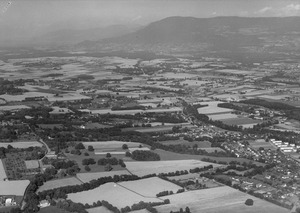Chêne-Bourg facts for kids
Quick facts for kids
Chêne-Bourg
|
||
|---|---|---|
 |
||
|
||
| Country | Switzerland | |
| Canton | Geneva | |
| District | n.a. | |
| Area | ||
| • Total | 1.28 km2 (0.49 sq mi) | |
| Elevation | 426 m (1,398 ft) | |
| Population
(Dec 2020 )
|
||
| • Total | 8,791 | |
| • Density | 6,868/km2 (17,790/sq mi) | |
| Postal code |
1225
|
|
| Surrounded by | Chêne-Bougeries, Thônex, Vandœuvres | |
Chêne-Bourg is a town in Switzerland. It is a municipality located in the canton of Geneva. This charming town is known for its green spaces and friendly community.
Contents
History of Chêne-Bourg
Chêne-Bourg was first mentioned way back in 1270. Back then, it was known as Quercus. This is a Latin word for oak tree.
In 1869, Chêne-Bourg became its own independent town. Before that, it was part of a larger area called Chêne-Thônex. It split into two separate municipalities: Chêne-Bourg and Thônex.
Geography of Chêne-Bourg
Chêne-Bourg covers an area of about 1.28 square kilometers (0.49 sq mi). A small part of this land, about 8.6%, is used for farming. Forests cover about 3.1% of the area.
Most of the land, about 87.5%, is developed. This means it has buildings, roads, and other structures. For example, about 59.4% of the area has homes and other buildings. Roads and transport take up 15.6%. Parks and sports fields make up 8.6% of the built-up area.
The town is located on the left side of Lake Geneva. It also sits by the Seymaz river. Part of Chêne-Bourg is surrounded by the town of Thônex.
Outside its old town center, Chêne-Bourg is quite busy. It has many houses and small apartment buildings. The town is divided into several smaller areas. These include Vieux-Bourg, Petit-Senn - Floraire, Chêne-Bourg - centre, Plateau de Bel-Air, and Petit-Bel-Air.
People of Chêne-Bourg (Demographics)
Chêne-Bourg has a population of about 8,100 people (as of 2023). A good number of people living here are from other countries. In 2008, about 34.6% of the population were foreign nationals.
Most people in Chêne-Bourg speak French. About 80% of the population uses French. Portuguese is the second most common language. About 4.8% of residents speak it. Italian is third, spoken by about 3.6% of the people.
The population is made up of slightly more women than men. In 2008, about 47.1% were male and 52.9% were female. Many people were born in Chêne-Bourg or elsewhere in Switzerland. About 39% of the residents were born outside of Switzerland.
The town has a good mix of age groups. Children and teenagers (0–19 years old) make up about 23.3% of the population. Adults (20–64 years old) are the largest group, at 63.3%. Seniors (over 64 years old) make up about 13.3%.
Most households in Chêne-Bourg have about 2.1 people. Many households, about 38.5%, are made up of just one person. There are also many families with children living in the town.
Notable Residents
Some famous people have connections to Chêne-Bourg.
Louis Favre, a well-known engineer, was born here.
The famous pianist Dinu Lipatti is buried in the cemetery of Chêne-Bourg. His wife, Madeleine, is also buried there.
Economy of Chêne-Bourg
Chêne-Bourg has a varied economy. Many people work in different types of jobs.
The workshop of the famous watchmaker Frédérique Constant is located in Chêne-Bourg. This shows that the town has skilled craftspeople.
In 2008, about 1,032 people worked in the manufacturing and construction industries. These are part of the secondary sector. This means they make things or build structures.
Even more people, about 1,776, worked in the tertiary sector. This sector includes jobs like sales, transportation, hotels, and healthcare. For example, many people work in shops, restaurants, or in offices. Others work as technical experts or in education.
Chêne-Bourg is a place where many people come to work. More workers travel into the town for their jobs than leave it. About 36% of workers use public transportation to get to work. About 41.3% use a private car.
Religion in Chêne-Bourg
Many different religions are practiced in Chêne-Bourg. According to a 2000 survey, about 43.1% of the people were Roman Catholic. About 14.6% belonged to the Swiss Reformed Church.
There are also smaller groups of other Christian churches. Some residents are Islamic, and a few are Jewish. Many people in Chêne-Bourg also say they don't belong to any church.
Education in Chêne-Bourg
Education is important in Chêne-Bourg. Many people have completed higher education. About 29.1% of the population has finished upper secondary education. This is like high school. Another 17.3% have gone on to university or other higher schools.
The school system in Geneva, where Chêne-Bourg is located, offers two years of non-mandatory Kindergarten. After that, students attend six years of primary school. Some children might go to special, smaller classes if needed.
After primary school, students go to secondary school. This includes three years of required schooling. Then, they can choose to continue for three to five more years in advanced schools. In the 2009-2010 school year, there were 1,667 students in the Chêne-Bourg school system.
Transportation
Chêne-Bourg has a railway station called Chêne-Bourg. This station is part of the CEVA railway line. Modern trains offer frequent service from this station. You can easily travel to Geneva and other places using the Léman Express train service.
Images for kids
See also
 In Spanish: Chêne-Bourg para niños
In Spanish: Chêne-Bourg para niños










